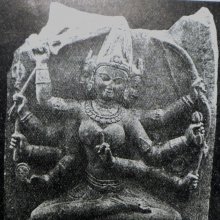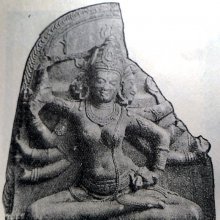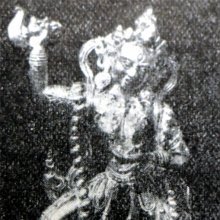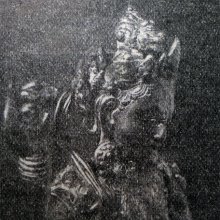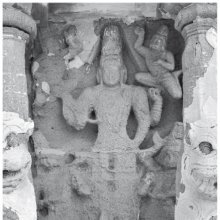Face, Facing, Faced: 2 definitions
Introduction:
Face means something in Hinduism, Sanskrit. If you want to know the exact meaning, history, etymology or English translation of this term then check out the descriptions on this page. Add your comment or reference to a book if you want to contribute to this summary article.
Images (photo gallery)
(+441 more images available)
In Hinduism
Natyashastra (theatrics and dramaturgy)
Source: Shodhganga: Elements of Art and Architecture in the Trtiyakhanda of the Visnudharmottarapurana (natya)1) The Face includes minor Body Parts through which are expressed various gestures (in Sanskrit Dramas), as conveyed through Āṅgikābhinaya: one of the four divisions of Abhinaya or “ways to convey or represent one’s emotion to others”, according to the Nāṭyaśāstra and the Viṣṇudharmottarapurāṇa, an ancient Sanskrit text which (being encyclopedic in nature) deals with a variety of cultural topics such as arts, architecture, music, grammar and astronomy.—The āṅgikābhinaya includes the histrionic representation of the limbs which is simply known as physical gestures.
The upāṅgas denote different parts of the Face. These are also six in numbers viz.,
- eyes,
- eyebrows,
- nose,
- lower
- lip,
- cheeks and
- chin.
2) The Face and other Limbs (in Indian Dramas) were commonly painted, as conveyed through the Aṅgaracanā division of Āhāryābhinaya.—Aṅgaracanā meaning painting of limbs of different characters, also falls under the category of makeover. [...] Applying of moustaches and beard can be called an important make-up in facial decoration. The Nāṭyaśāstra says that after painting the face and other limbs the characters are provided with beard according to their territory, profession and spiritual rites.

Natyashastra (नाट्यशास्त्र, nāṭyaśāstra) refers to both the ancient Indian tradition (shastra) of performing arts, (natya—theatrics, drama, dance, music), as well as the name of a Sanskrit work dealing with these subjects. It also teaches the rules for composing Dramatic plays (nataka), construction and performance of Theater, and Poetic works (kavya).
Yoga (school of philosophy)
Source: ORA: Amanaska (king of all yogas): A Critical Edition and Annotated Translation by Jason BirchFacing (the highest reality) is denoted by the Sanskrit term Saṃmukha, according to the Amanaska Yoga treatise dealing with meditation, absorption, yogic powers and liberation.—Accordingly, as Īśvara says to Vāmadeva: “[...] [Now], I will teach the practice of that, which produces absorption. [...] The Yogin, who is free from all thoughts in regard to [everything] internal and external, should meditate with [his] mind on nothing. [Then,] he becomes one who faces (saṃmukha) the highest reality. [...]”.

Yoga is originally considered a branch of Hindu philosophy (astika), but both ancient and modern Yoga combine the physical, mental and spiritual. Yoga teaches various physical techniques also known as āsanas (postures), used for various purposes (eg., meditation, contemplation, relaxation).
See also (Relevant definitions)
Ends with: Devil face, Fundamental Face, Pepper face, Pigface, Surface, Upward face.
Full-text (+6898): Sammukha, Anana, Mukha, Abhimukha, Adhomukha, Caturmukha, Vadana, Shadanana, Pancanana, Caturanana, Pratyanmukha, Pancamukha, Shanmukha, Pancavaktra, Krishnavaktra, Dakshinabhimukha, Unmukha, Sumukha, Vishvatomukha, Pranmukha.
Relevant text
Search found 457 books and stories containing Face, Facing, Faced; (plurals include: Faces, Facings, Faceds). You can also click to the full overview containing English textual excerpts. Below are direct links for the most relevant articles:
The Tattvasangraha [with commentary] (by Ganganatha Jha)
Verse 1990-1992 < [Chapter 23 - External World]
Verse 1993-1997 < [Chapter 23 - External World]
Verse 2588-2590 < [Chapter 24b - Arguments against the reliability of the Veda (the Revealed Word)]
The Indian Buddhist Iconography (by Benoytosh Bhattachacharyya)
Figure 147 - Emanations of Akṣobhya: Dhvajāgrakeyūrā
Figure 215-216 - Four Animal-Faced Goddesses: Siṃhāsyā
Shaiva Upanishads (A Critical Study) (by Arpita Chakraborty)
8. Various faces of Rudrākṣa and their benefits < [Chapter 4 - A Critical approach to Rudrākṣa based on Śaiva Upaniṣads]
8a. Five kinds of Bhasma < [Chapter 2 - Greatness of Bhasma and Dhāraṇa]
17. The esoteric significance of Five Faces of Lord Śiva < [Chapter 5 - Essence of Pañcabrahma Upaniṣad]
Rudra-Shiva concept (Study) (by Maumita Bhattacharjee)
2.35. Śiva as Pañcānana < [Chapter 6a - The Epithets of Rudra-Śiva]
2. Physical appearance of Śiva < [Chapter 5 - Rudra-Śiva in the Purāṇic Literature]
1. Rudra-Śiva In The Āraṇyaka Literature < [Chapter 4 - Rudra-Śiva in the Post-Brāhmaṇic Literature]
Vinaya (3): The Cullavagga (by T. W. Rhys Davids)
Cullavagga, Khandaka 5, Chapter 16 < [Khandaka 5 - On the Daily Life of the Bhikkhus]
Cullavagga, Khandaka 5, Chapter 14 < [Khandaka 5 - On the Daily Life of the Bhikkhus]
Cullavagga, Khandaka 5, Chapter 2 < [Khandaka 5 - On the Daily Life of the Bhikkhus]
Puranic encyclopaedia (by Vettam Mani)
Related products
(+388 more products available)
.jpg)
